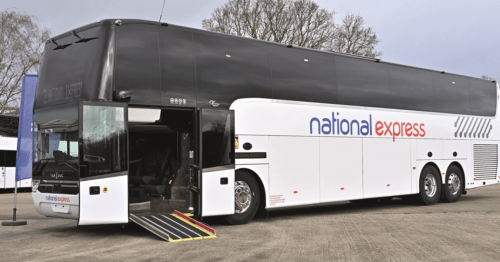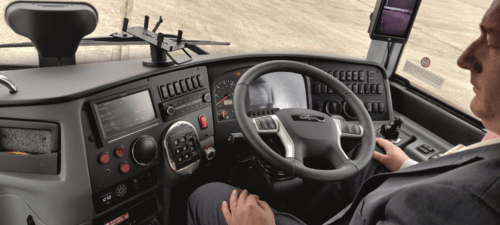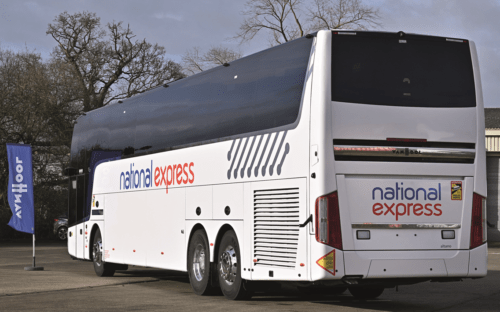
Adrian Morton reports from the launch of National Express’ new Van Hool Altano coaches on 15 March
I set off from home in semi-rural Cheshire at 6.30am in the pouring rain, allowing myself plenty of time to reach Van Hool UK’s premises in Wellingborough by 10.30. Rather surprisingly the M6 was kind to me, so arriving with plenty of time to spare I went first to a nearby Tesco superstore in the hunt for some much needed breakfast. It was here I saw parked one of Souls of Olney’s tri-axle Volvo B9TL 100-seat Optare Olympus double-deckers dating from 2009; these vehicles are of particular interest to me as I operated six identical vehicles at Mortons, with only penny numbers ever being produced. Anyway, back to the matters that brought me here and after a further five minute drive I had arrived at Van Hool and was warmly welcomed by Nikki Houghton, National Express’ UK Communications Manager. The striking Van Hool Altano TDX21 was immediately apparent, glistening in a short burst of sunshine, a far cry from the weather I had experienced earlier in the day.
On a high
Altano refers to the most characteristic feature of this coach, that being the height of the cavernous luggage holds (altus being Latin for ‘high’). Those on the 14.4m long and 3.73m high model chosen by National Express boast an impressive 16.5m3 of capacity. Van Hool used to produce its own seats but Kiel is now the preferred supplier, with 63 reclining seats on the upper-deck and three on the lower-deck of this coach, and space for one wheelchair.
[wlm_nonmember][…]By subscribing you will benefit from:
- Operator & Supplier Profiles
- Face-to-Face Interviews
- Lastest News
- Test Drives and Reviews
- Legal Updates
- Route Focus
- Industry Insider Opinions
- Passenger Perspective
- Vehicle Launches
- and much more!
Access for a wheelchair user is made easy for both driver and passenger with a low entry, kneeling suspension and very simple fold out manual ramp. This meets National Express’ preferred option for social inclusion of disabled passengers accessing through the front of the vehicle as per the Caetano Levante, but banishes the need for any mechanical lift. There are of course distinct operational advantages here, eliminating the many obstacles associated with passenger lifts on a vehicle. There is of course the initial purchase price of the lift and associated on-going maintenance costs, and they add significant weight to a vehicle, take additional time, require a larger amount of space to deploy and need regular servicing and testing.
In my eyes the TDX21 shines through here. The leather reclining seats were comfortable, boast adjustable headrests, a fold out tray table and USB charging points, although for someone like me who is 6’3’’ legroom was somewhat lacking. I wish not to be too critical here as I appreciate my height is above the norm, and if I travel by other means, be that rail or air, I am now resigned to the fact I have to pay for a premium offering for the legroom I desire. My own business model at Mortons was centred on capacity so the more seats in a vehicle, the higher your yield and these vehicles are destined for routes where demand often outstrips supply.
Free WiFi is provided, and Eberspacher climate control. There’s a spacious floor mounted toilet, and a feature that has now been offered for some time by Van Hool is the provision of LED mood lighting. The coach is powered by a 12.9-litre DAF Paccar MX-13 530bhp Euro VI engine, driving through a fully automated Allison six-speed gearbox. Huge 752-litre fuel tanks reduce the number of times the coach has to stop to refuel. In true National Express style, safety features are abundant including an Alcolock, the Guardian fatigue monitoring system, and a Lytx DriveCam.

Why Van Hool?
I spoke with Ed Rickard, Network Director for National Express UK and Ireland, and asked why Van Hool had been selected to supply these vehicles for the network. He told me: “We wanted a high-capacity coach with good luggage space and a simple more efficient and faster way to board our wheelchair customers.”
The routes they have been selected for are the 540 from Manchester to London, operated by Selwyns Travel, and the 040 from Bristol to London operated by Edwards Coaches of South Wales, both long-standing partners of National Express. Here they will gradually replace the Caetano Boa Vista double-deck coaches, some of which will be displaced to other National Express fleets for use on private hire work. “Both routes have seen huge increases in demand. With the cost-of-living crisis, coach is seen as an affordable option. Rail strikes saw a modal shift and we’ve concluded that at least 10% stayed with us and didn’t go back. The routes they will be on have stiff competition, so cheap fares on these corridors increases demand. The Van Hool Altano offers a competitive edge with high quality and high capacity,” Ed added.
Alastair Coxon, Director of Third Party Hiring & Fleet, was also present at the launch and helped give me further insight into why Van Hool was the chosen supplier for these vehicles. I asked if the over-decker will now spell the end for double-deck coaches on National Express routes. “I can’t say for sure but we rigorously looked at what was on the market and the Van Hool Altano offers us a far greater luggage capacity, but more importantly is much more driver friendly,” Alastair said. “With our double-deck coaches drivers are having to lift heavy and bulky items to at least above waist level in order to get articles into the vehicle. In a first for Van Hool on the Altano in the UK, we asked if the continental door could be positioned on the offside. This further enhanced the space available to drivers when loading luggage from the kerb, but consideration was also given to the vehicle’s afterlife, when it is stood down from the network.
“Similar vehicles have successfully been operated in our Kings Ferry fleet on private hire applications and by having the centre door on the right affords us the opportunity after scheduled coach work for continental touring, not just for us but also for any subsequent purchaser of the vehicle, further enhancing its residual value.”
I asked about what the future holds for the current collaboration between National Express and Portuguese manufacturer Caetano. “The Altanos have a specific role,” Alastair clarified. “120 Levante 3A tri-axles are currently on order for other services, some replacing older vehicles as part of our natural fleet replacement programme, and others to grow the network.”


Operator praise
Twenty-five Altanos are due in total over the coming months, 10 for Edwards and 15 for Selwyns. Out of a fleet of around 200 vehicles operating from three main depots, Edwards has around 90 vehicles dedicated to National Express work, roughly 25% of the network.
Mike Edwards, Managing Director at Edwards Coaches, enthused: “The Van Hool is a lovely product. It’s a game changer for drivers where the luggage is concerned. We currently have three Van Hool over-deckers in the fleet. One is the Cardiff ice hockey team coach. I’m really looking forward to seeing them on the road.”
They come in a year where Edwards is investing £35m in new vehicles for both its National Express, tour and private hire fleet.
Selwyn Jones, Managing Director of Selwyns Travel, is no stranger to the Van Hool/DAF combination. He told me: “They are fabulous vehicles. The specification is superb. The first one here is for Edwards but I’m looking forward to seeing these in our fleet.”
The Altano is currently built at Van Hool’s Koningshooikt factory in Belgium but production of this, along with the T series, will shortly move to North Macedonia. The UK market has always been an important one for Van Hool with around 70 units expected to be delivered over the next year. Post-Covid conditions have resulted in significant change within many vehicle builders, the supply of components being a big restraint. For the UK, lead time on a new Van Hool from order to delivery is currently around 14 months. Despite the recent news regarding Van Hool’s turn-around plans for its business, demand for new coaches is extremely high and the mood amongst its staff extremely positive.



Impressive drive
A short drive of the initial vehicle for Edwards Coaches gave me some insight to this impressive beast. Acceleration was rapid, the Allison automatic gearbox providing a smooth, effortless and quiet change, with plenty of power from the 13 litre DAF Paccar MX-13 engine. Moving out from under the bonnet, the refined quality and rattle-free build quality for which Van Hool is known was immediately apparent.
This was only the second time I have had the opportunity to drive a vehicle with rear view digital cameras. The first, now some time ago, failed to impress me. Perhaps I just didn’t want to embrace the technology. But after driving the Altano I could well be persuaded if I were to ever again purchase a new coach myself. Visibility was very clear and it was a relatively easy transition from external mirrors to interior monitors. However, although an offside rear camera would come alive on a different screen when you indicated left and vice-versa, I still thought it particularly hard to judge where the back end was compared to standard mirrors. I think having several screens to look at was also off putting but a more comprehensive drive may help to allay those fears.
The absence of a kerb or forward facing mirror was also apparent; I was told this would either require yet another additional monitor or the return of a traditional mirror. I still have huge reservations around vehicle downtime and customer inconvenience should the system fail though – should a mirror get broken I am sure it is far easier to replace, let alone identify the fault first in a camera-based system.
Over 50% of all Van Hool coaches being produced have customers specifying the system. I think too the TDX21 body suits a mirrorless look, where some from other manufactures look totally obscure in their styling without conventional mirrors.
Dave Porter from Van Hool quoted that the system costs around £5,000 but on a vehicle costing £485,000 surely that’s a drop in the ocean! Dave put forward a very good argument following a conversation with one of his customers, which as a former operator made me sit up and think: how many coach mirrors on a vehicle have we replaced at £1,500 a time?
As stated it was only a very short drive and I very much hope to do a full road test in the near future. The only thing I could find to fault were the door buttons. There are three, one each for the front and rear leaves of the main forward passenger door and one for the offside continental door. They are not clearly labelled and are all next to each other; a simple fix but at present it would be very easy to open the offside door when you didn’t intend to – and that may be in the tight constraints of Victoria Coach Station for example, where damage could be caused.


Conclusions
So, as an operator would I buy a Van Hool Altano TDX21 in this configuration? If I had the right application for one then undoubtedly yes. The DAF Paccar MX-13 engine is highly fuel efficient and renowned for its reliability with repair and maintenance costs drastically reduced by maintenance intervals of up to 200,000km. People used to ask me ‘why do you run so may DAF’s? Dealer support is poor and parts prices are stupidly expensive.’
The simple answer to that was because they always came home! They were super reliable so my attention was never drawn to poor dealer support or exorbitant parts prices. Add on a body by one of the most esteemed coach body manufacturers of my generation and what’s not to like? Van Hool UK is also extremely fortunate to employ some of the most talented engineers I have ever had the pleasure of dealing with, and the same can be said for its sales team, so I would have no hesitation in believing the product would not be fully supported.
I mentioned previously having the right application, and I think the downside for many would be the length. That said, it ticks every single box as a multi-purpose vehicle; the price tag may be high but the wheels should never stop turning and the residual value of such a vehicle will be strong. The PSVAR element and ease of loading wheelchairs makes it quite obviously ideal for its intended purpose of scheduled express work, but also for rail replacement.
The specification also lends itself to UK and continental touring, corporate hire, cruise ship transfers with its huge luggage hold, and high-capacity school work in place of a double-decker or 3+2-seated school coach. The toilet is demountable and, though not specified by National Express, two seats can be fitted on tracking in the wheelchair bay bringing the total capacity up to 70 passengers. From a driver’s perspective I personally think I would find it a lonely proposition sitting downstairs, probably more often than not on my own, but I know a great deal of my colleagues would much prefer that option, especially on scheduled work!
[/wlm_ismember]

